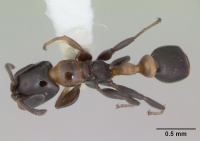Pseudomyrmex laevifrons
| Pseudomyrmex laevifrons | |
|---|---|

| |
| Scientific classification | |
| Kingdom: | Animalia |
| Phylum: | Arthropoda |
| Class: | Insecta |
| Order: | Hymenoptera |
| Family: | Formicidae |
| Subfamily: | Pseudomyrmecinae |
| Genus: | Pseudomyrmex |
| Species group: | goeldii |
| Species: | P. laevifrons |
| Binomial name | |
| Pseudomyrmex laevifrons Ward, 1989 | |
| Synonyms | |
| |
Most collections consist of scattered foragers on low vegetation and on recent treefalls. I have collected seven nest series, all from dead twigs of woody plants: two from vines, three from Melastomataceae trees, and two from unidentified plants. (Ward 2017)
Identification
Ward (2017) - Workers of this species can be recognized by their small size (HW 0.47–0.55), shiny puncticulate head, angulate propodeum, and the presence of a single pair of erect setae on the pronotal humeri, petiole and postpetiole. Pseudomyrmex obtusus and Pseudomyrmex parvulus have a more densely sculptured head and less standing pilosity (lacking at least on the petiole). Differences between Pseudomyrmex laevifrons and the closely similar Pseudomyrmex micans are discussed under the latter species.
Keys including this Species
Distribution
Ward (2017) - This species is distributed from Nicaragua to Bolivia and central Brazil, and has been recorded from tropical moist forest, rainforest, second-growth rainforest, and rainforest edge.
Latitudinal Distribution Pattern
Latitudinal Range: 10.648° to -14.79861111°.
| North Temperate |
North Subtropical |
Tropical | South Subtropical |
South Temperate |
- Source: AntMaps
Distribution based on Regional Taxon Lists
Neotropical Region: Bolivia, Brazil (type locality), Costa Rica, French Guiana.
Distribution based on AntMaps
Distribution based on AntWeb specimens
Check data from AntWeb
Countries Occupied
| Number of countries occupied by this species based on AntWiki Regional Taxon Lists. In general, fewer countries occupied indicates a narrower range, while more countries indicates a more widespread species. |

|
Estimated Abundance
| Relative abundance based on number of AntMaps records per species (this species within the purple bar). Fewer records (to the left) indicates a less abundant/encountered species while more records (to the right) indicates more abundant/encountered species. |

|
Biology
Castes
Nomenclature
The following information is derived from Barry Bolton's Online Catalogue of the Ants of the World.
- laeviceps. Pseudomyrma laeviceps Smith, F. 1877b: 63 (w.) BRAZIL. [Misspelled as leviceps by Dalla Torre, 1893: 57.] Combination in Pseudomyrmex: Kusnezov, 1964: 83. [Junior primary homonym of laeviceps Smith, F. 1859a: 145, above.]. Replacement name: laevifrons Ward, 1989: 440.
- laevifrons. Pseudomyrmex laevifrons Ward, 1989: 440. Replacement name for laeviceps Smith, F. 1877b: 63, above. [Junior primary homonym of laeviceps Smith, F. 1859a: 145.]
The following notes on F. Smith type specimens have been provided by Barry Bolton (details):
Pseudomyrma laeviceps
Holotype worker in Oxford University Museum of Natural History. With two labels, “Aru 21” and “Aru.”
Description
Small species (HL 0.65–0.75, HW 0.47–0.55) with elongate head and eyes (CI 0.69–0.78, REL 0.57–0.64, REL2 0.79–0.87); masticatory margin of mandible with 5 teeth; palp formula 4,3; juncture between dorsal and declivitous faces of propodeum usually notably angulate, sometimes producing slight tubercles laterally; anterodorsal face of petiole usually ascending relatively steeply (Fig. 5b). Head smooth and shiny with scattered fine punctulae; pronotum similar centrally, but remainder of mesosoma becoming sublucid, with coriarious-imbricate sculpture on most surfaces including mesopleuron, metapleuron and propodeum; petiole, postpetiole and gaster with moderately dense pubescence. Standing pilosity sparse (MSC 2); paired erect setae present on pronotal humeri, petiole and postpetiole. Dark brown, mandibles, frontoclypeal complex and tarsi lighter; pronotum, petiole and postpetiole often a contrastingly lighter medium- to yellowish-brown.
Ward (2017) - (n = 16). HL 0.65–0.75, HW 0.47–0.55, MFC 0.005–0.010, LHT 0.36–0.41, CI 0.69– 0.78, REL 0.57–0.64, REL2 0.79–0.87, FCI 0.010–0.019, FI 0.50–0.56, PLI 0.66–0.80, PWI 0.54–0.66.
Type Material
Ward (1989) - Two syntype workers, Para. Brazil (The Natural History Museum) [Examined]. One syntype worker here designated LECTOTYPE.
References
- Franco, W., Ladino, N., Delabie, J.H.C., Dejean, A., Orivel, J., Fichaux, M., Groc, S., Leponce, M., Feitosa, R.M. 2019. First checklist of the ants (Hymenoptera: Formicidae) of French Guiana. Zootaxa 4674, 509–543 (doi:10.11646/zootaxa.4674.5.2).
- Smith, F. 1877b. Descriptions of new species of the genera Pseudomyrma and Tetraponera, belonging to the family Myrmicidae. Trans. Entomol. Soc. Lond. 1877: 57-72 (page 63, Replacement name for laeviceps)
- Ward, P. S. 1989a. Systematic studies on pseudomyrmecine ants: revision of the Pseudomyrmex oculatus and P. subtilissimus species groups, with taxonomic comments on other species. Quaest. Entomol. 25: 393-468 (page 440, Replacement name for laeviceps)
- Ward, P.S. 2017. A review of the Pseudomyrmex ferrugineus and Pseudomyrmex goeldii species groups: acacia-ants and relatives (Hymenoptera: Formicidae). Zootaxa 4227: 524–542 (doi: 10.11646/zootaxa.4227.4.3).
References based on Global Ant Biodiversity Informatics
- Brandao, C.R.F. 1991. Adendos ao catalogo abreviado das formigas da regiao neotropical (Hymenoptera: Formicidae). Rev. Bras. Entomol. 35: 319-412.
- Fernández F., E. E. Palacio, W. P. Mackay, and E. S. MacKay. 1996. Introducción al estudio de las hormigas (Hymenoptera: Formicidae) de Colombia. Pp. 349-412 in: Andrade M. G., G. Amat García, and F. Fernández. (eds.) 1996. Insectos de Colombia. Estudios escogidos. Bogotá: Academia Colombiana de Ciencias Exactas, Físicas y Naturales, 541 pp
- Franco W., N. Ladino, J. H. C. Delabie, A. Dejean, J. Orivel, M. Fichaux, S. Groc, M. Leponce, and R. M. Feitosa. 2019. First checklist of the ants (Hymenoptera: Formicidae) of French Guiana. Zootaxa 4674(5): 509-543.
- Kempf, W.W. 1972. Catalago abreviado das formigas da regiao Neotropical (Hym. Formicidae) Studia Entomologica 15(1-4).
- Smith F. 1863. Catalogue of hymenopterous insects collected by Mr. A. R. Wallace in the islands of Mysol, Ceram, Waigiou, Bouru and Timor. Journal and Proceedings of the Linnean Society of London. Zoology 7: 6-48.

